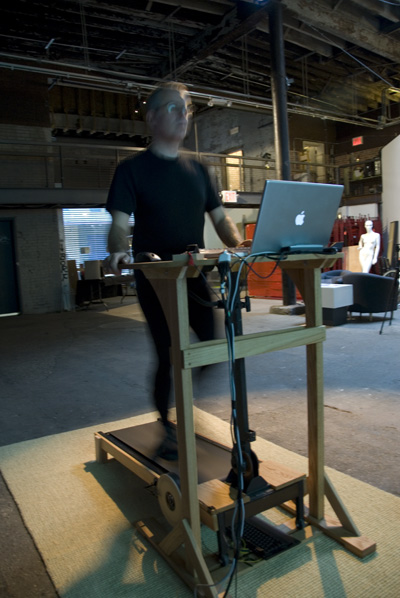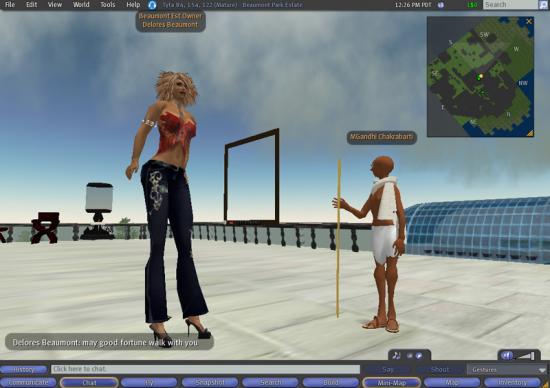



Feurbach’s “The Essence of Christianity” (1843) discusses the importance we make of images and illusions, and that we prefer “the image to the thing, the copy to the original, the representation to the reality, appearance to being”. Second Life, the 3-D online ecosystem that is created and maintained by those who virtually inhabit it, is arguably a testament to our culture’s embrace of this level of fantasy and denial of the Real, which Ludwig Feuerbach had presciently observed shortly after the invention of the camera.
However, bringing to light this realization isn’t to suggest that Second Life doesn’t have its appeal to those of us who don’t barter, exchange, purchase, and develop friendships within its virtual walls. Life on the outside might still be a preferred existence to most. Still, it can be alluring for all to discover the blurred boundaries between virtual and real, avatar and human, representation and being, illuminating possibilities within a world that very closely parallels ours. Joseph DeLappe’s recent project, aptly a social experiment encased in a shell of net art, creates a space of in-betweenness that invites us to experience elements of both worlds without committing either.
Realized in several stages, DeLappe’s virtual re-creation of The Salt Satyagraha, Mahatma Ghandi’s Salt March to Dandi, a journey 240 miles long, is part installation and part performance art. His historical re-enactment reveals more about how virtual space is navigated from real space than it explains the politics of Mahatma Ghandi’s protest against the British salt tax in 1930, utilizing travel in real space, a blog, and images from the journey housed on Flickr.
DeLappe’s re-creation relies on Second Life to provide a virtual landscape of India and an avatar that sports the likeness of Ghandi. DeLappe’s role in this excursion is to propel the avatar through this space utilizing his physical movement in reality, creating a visceral connection to the march and providing a personality to an otherwise soulless avatar. As part of DeLappe’s mission, he welcomed strange participants along his path to join him in his peace march by offering a walking staff. These participants met him on Second Life while real-life participants also served as spectators of his journey at Eyebeam’s Chelsea gallery.

A custom-designed treadmill in Real Life provides movement through Second Life. DeLappe, the avatar’s human counterpart, takes the journey seriously, wearing comfortable shoes, a T-shirt, and gym pants for the stretch of the march, which he achieves over 26 days. The treadmill has a wooden desk for his laptop, a bottle of water, and a coffee mug; a leather cushion at abdomen height provides ample comfort for his journey through cyberspace. His activity through cyberspace is projected onto a wall.
The relationship between two sometimes disparate and sometimes mirroring worlds is in constant negotiation. When Second Life crashes, DeLappe and his avatar are kicked out of the system. A simple reboot will bring them back, though the interruption results in a system error that forces his avatar to return to the location he had at the beginning of the day, purging the data it had collected since that point. DeLappe, by now familiar with this setback, wanders away from his treadmill station to grab a nutrition bar. After another day of cyber navigation, he calmly resumes his initial position and dives back in.
To think that there isn’t tension in virtual space is a misunderstanding of how closely we connect ourselves to our virtual counterparts in the social context of Second Life. It is a utopian space, on the one hand, as it enables users to, in some way, materialize personas that are otherwise only possible in one’s imagination. However, conflicts abound in relationship to those personas – reactions to where they lie politically, socially, and economically – and to the limited nature of communication through text. DeLappe’s Ghandi was no exception when he encountered Storm36Thor, a long-haired thug with a beefy build, a machine gun, and a T-shirt with the acronym FBI written across it. Their encounter was initiated by gunfire, as Storm36 Thor shot in the air to announce his authority.
Disinterested in and perhaps unaware of who Mahatma Gandhi was, Storm36 Thor was unimpressed by DeLappe’s introduction and by the idea of joining him on his journey. A self-described ‘trigger happy’ avatar, the human behind Storm36Thor could have been anyone from a reckless teenager to a bored executive. There is no way of knowing the age, gender, political leaning, or social or economic status of the person behind the avatar. Yet the encounter gave DeLappe and his audience a window into virtual violence (unnecessary gunfire), social interactivity (introducing oneself to another) and theatre (heightened persona).

The exploration of how these two environments engage with one another creates a third environment that is neither fully virtual nor fully real but instead rests between the two in a space informed by each of them. This third space relies on both for inspiration, historical context, and creativity. How we socially interact with each other in real life is the basis for how we socially interact in virtual space, but the two interactions greatly differ. While an avatar represents a human being, it is not wholly or truthfully reflective of the human who created it. And for those of us in DeLappe’s audience in physical space, our interaction with all is distanced and removed.
With respect to his interaction with Storm36Thor, DeLappe was comfortable with the level of tension they generated in cyberspace, perhaps more than he might be in real life, and playfully antagonized him by questioning his use of a machine gun in declared virtual a safe zone, the plaza of a mall. Their displayed interaction became an entertainment vehicle, bringing his physical spectators into the realm of his theatre. In this case, the virtual confrontation had no consequences as each eventually wandered away from the other in boredom.
The second stage of this Second Life project is a 17-foot cardboard papercraft sculpture of Mahatma Gandhi’s avatar currently on display at Eyebeam. This representation of a real person is the same size as Michelangelo’s David, produced using a 3-D rapid prototype printing technology from the 8-inch avatar.
The mixed layers of real and fantasy, history and re-enactment, and human and representation between every phase of DeLappe’s project become more difficult to distinguish, mirroring our postmodern sensibility and the mediated extensions that history and human life produce. One can only think of how we might further add to these dimensions of possibility, and create worlds of existence that don?t rely on the relationship between space and time.